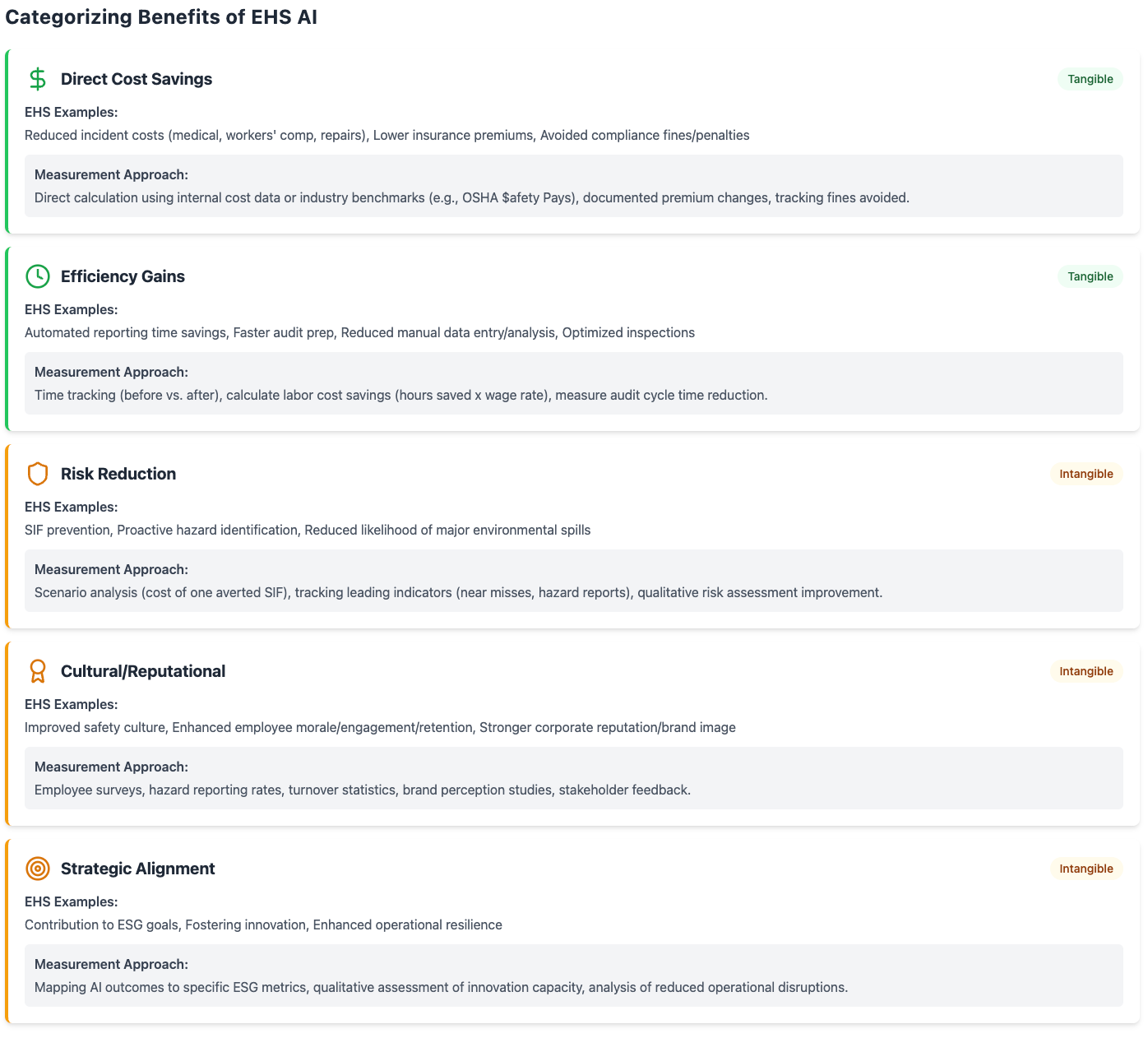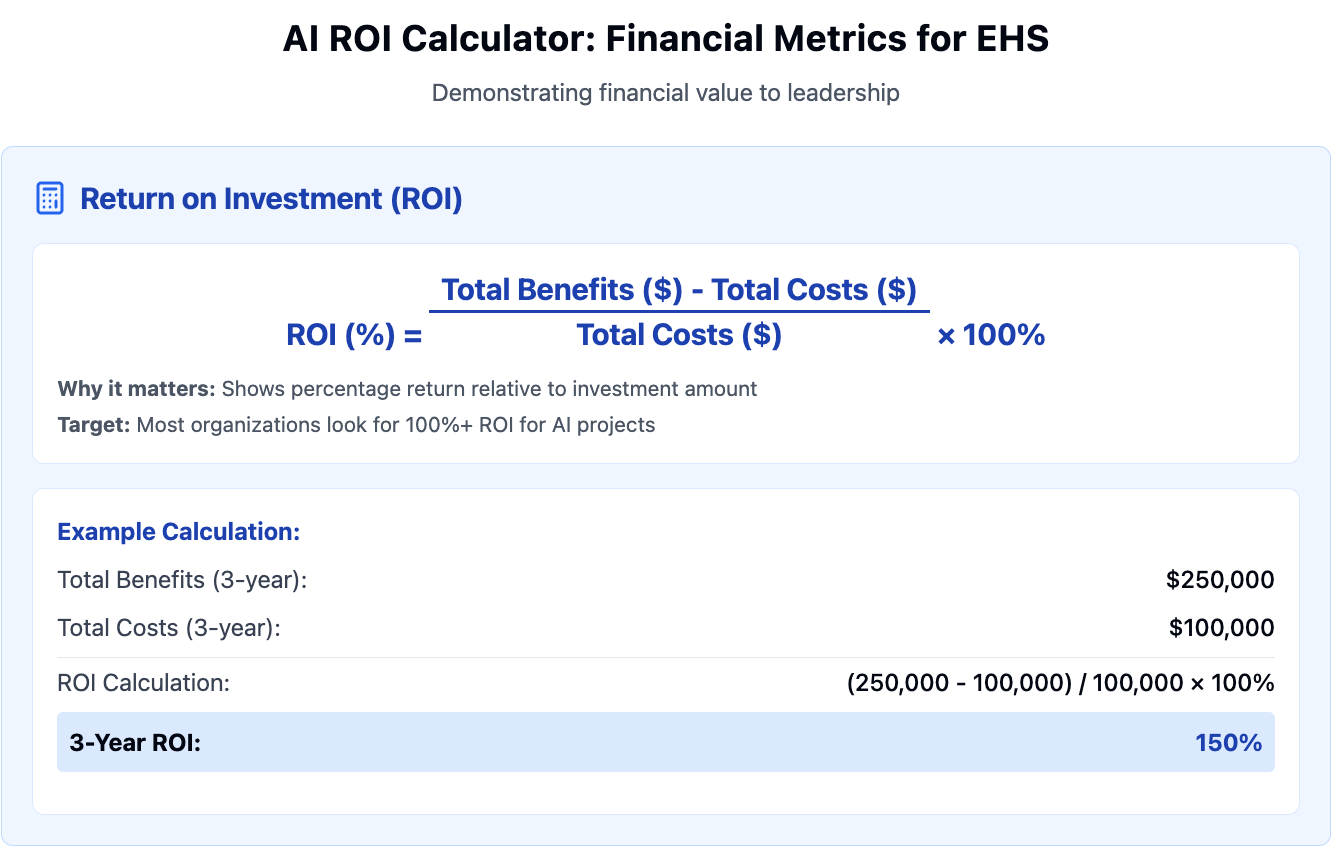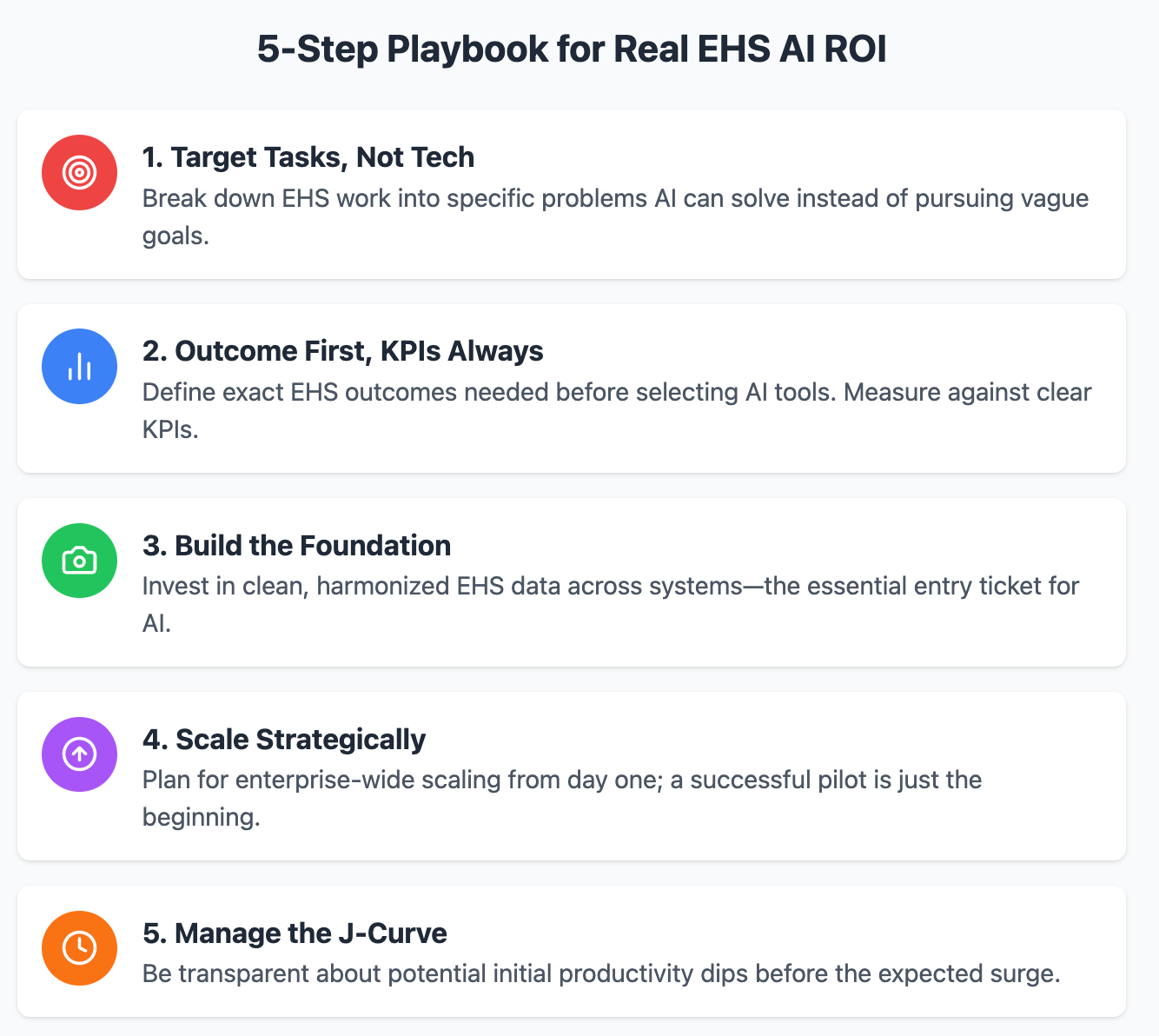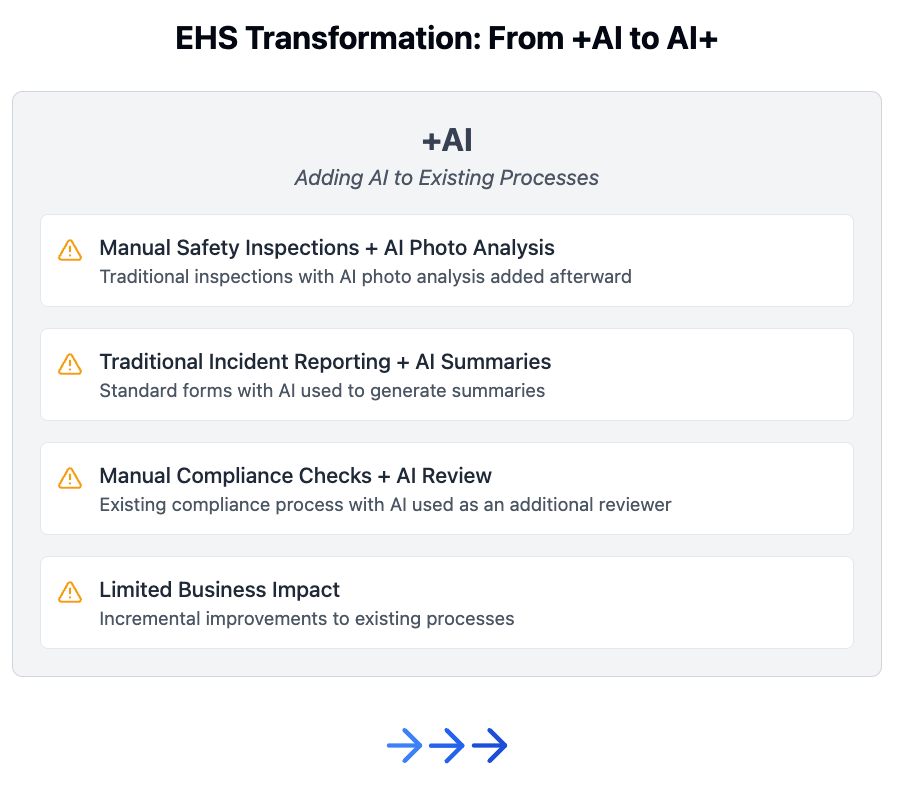AI for EHS Leaders (Part 3/3): How Do I Justify the Cost of AI in EHS and Prove It Actually Works?
A practical guide for EHS executives to demonstrate ROI and secure buy-in for AI initiatives in EHS
Note: This post was developed through collaboration with Gemini 2.5 Pro and Claude 3.7 Sonnet, AI assistants by Google and Anthropic respectively. We provided the concept, direction, and editorial oversight, while Gemini/Claude assisted with research, drafting, and editing. All final content decisions were our own.
Welcome to the final installment of our series on Artificial Intelligence for EHS Leaders. In Part 1, we explored fundamental AI concepts and their EHS applications. Part 2 tackled implementing AI safely, legally, and ethically. Now, we address the critical question: "How do I justify the cost and prove it actually works?" This is especially pertinent for AI, where potential is high but demonstrating tangible value can be murky. This guide provides a framework for evaluating AI's impact and building a compelling business case, transforming EHS from a cost center into a strategic value driver.
Why ROI Matters: Moving EHS Beyond a Cost Center
Traditionally, EHS departments have often been viewed primarily as cost centers – necessary for compliance, but not directly contributing to the bottom line. AI presents an opportunity to shift this perception. By demonstrating quantifiable improvements in efficiency, risk reduction, and cost savings, EHS leaders can position AI initiatives not just as necessary expenditures, but as strategic investments that contribute to overall business resilience, operational excellence, and even enhanced corporate reputation. In short: successfully justifying AI investment is about showcasing its alignment with broader business objectives.
Let's explore how to build that approach, demonstrate value, and position EHS as a strategic contributor to business success.
The AI Productivity Paradox: Why Most Companies Struggle with ROI
It’s important to note first that despite the growing enthusiasm for AI, a significant gap exists between adoption and value creation. Recent research reveals what experts call the "AI productivity paradox":
According to McKinsey's latest State of AI survey, 78% of companies now use artificial intelligence in at least one function (up from 55% in 2023). However, most of these organizations report limited financial returns—typically cost savings of less than 10% and revenue increases of less than 5%.
Why this disconnect? The 2025 AI Index report released by the Stanford Institute for Human-Centered Artificial Intelligence points to several key factors:
Stuck in "Pilot Purgatory": Only 1% of companies that have invested in AI report that they have scaled their implementation, while 43% remain in the pilot stage. As economist Erik Brynjolfsson notes, "Significant productivity improvements require achieving scale."
Technology-First Approach: Many companies start with the AI solution rather than the business problem. HP's Chief Data and Analytics Officer Scott Hallworth emphasizes that organizations should "target an outcome first, and then find the model that helps them achieve it."
Lack of Enterprise Orchestration: Moving beyond individualized AI usage (where employees use GenAI chatbots) to true enterprise adoption requires orchestration and scaling across the organization. Few companies have reached this level.
Missing Data Infrastructure: Successfully orchestrating AI across the enterprise requires the right infrastructure, especially harmonized data with consistent terminology and definitions.
For EHS leaders, these challenges manifest as "safety innovation theater"—impressive demos that don't translate to operational improvement. This includes fragmented pilots, metric misalignment, data disharmony, and hesitation to scale safety-critical applications.
Understanding the AI "J-Curve": Managing Expectations in EHS
One of the most critical concepts for EHS executives to grasp comes from Stanford economist Erik Brynjolfsson's research on the "J-curve" pattern of AI adoption. This pattern helps explain why so many leaders become disillusioned with AI initiatives that initially appear to be underperforming. The "J-curve" of AI adoption goes like this: after an initial dip in productivity as organizations figure things out, a significant upward surge in productivity and value is seen when mastery and scale is achieved.
The J-curve describes the typical productivity trajectory of transformative technologies:
Initial Investment Phase (the downward part of the J): During this period, organizations invest significant resources in technology, data preparation, process redesign, and training. Productivity often decreases temporarily as teams adapt to new systems and workflows.
Learning and Adaptation Phase (the bottom of the J): The organization works through implementation challenges, refines processes, and develops new capabilities. Productivity may plateau at a lower level than pre-implementation.
Value Realization Phase (the upward part of the J): As the organization masters the new technology and scaled implementation, productivity begins to surge, ultimately exceeding previous levels significantly.
Let’s look at this for EHS applications. Consider a company implementing AI for incident investigation:
Downward Slope: Initial implementation requires safety professionals to learn new systems, IT to establish integrations, and leadership to adjust governance. Investigations may temporarily take longer as teams navigate dual systems.
Bottom of the Curve: The organization addresses workflow issues, refines data inputs, and adjusts AI parameters based on feedback. Performance starts to stabilize but hasn't yet exceeded the previous baseline.
Upward Slope: As the system matures and adoption increases, investigation quality improves dramatically while time decreases. The organization begins applying insights across operations, creating compound benefits beyond the original scope.
What makes the J-curve particularly challenging for EHS leaders is the safety-critical nature of our functions. Unlike marketing or sales, where temporary disruptions might be tolerable, safety processes need to be maintained through the transition. Importantly, the research also suggests that the productivity curve may be steeper and faster for task-specific AI implementations versus broad, general-purpose deployments. This reinforces the value of the task-based approach for EHS leaders seeking to accelerate through the curve.
The Task-Based Resolution: Breaking Down EHS Work
The most promising approach to resolving this paradox comes from Stanford economist Erik Brynjolfsson's recommendation for "task-based analysis." For EHS leaders, this means decomposing your safety function into what he calls "atomic units of work" – discrete, repeatable tasks that can be evaluated for AI assistance.
Rather than asking "How can AI improve our safety program?" (too broad), consider specific tasks:
% of targeted training efforts improved
Reducing the time it takes to complete a Job Hazard Analysis (JHA)
Reducing the time to initiate corrective action after a hazard is identified
% of new hazards corrected with AI systems vs historical averages
% of increased engagement via click through rate of targeted safety communications based on trending issues
Each represents a concrete task where AI could potentially improve speed, consistency, or accuracy – and each can be measured against existing KPIs.
Once you’ve identified these atomic units of work, the next step is mapping them to where they live—inside your actual systems. Which system or module captures this data today? How is that task currently measured? Is there a workflow field or audit trail you can use to track AI impact on that task over time? For most teams, this means reviewing your EHS software setup and dashboards to make sure those “units of work” aren’t just conceptual—they’re actually visible in the system and measurable by design.
A Practical Framework for Demonstrating AI Value in EHS
In addition to the task based approach, we believe a structured, data-driven framework for pitching AI value for EHS is essential. Based on existing successful implementations, here's a practical framework for EHS executives looking to move beyond the productivity paradox:
1. Start with Strategy: Define Outcomes and Target Tasks
Target Outcomes First, Technology Second: Start with the business outcome you want to achieve, then find the AI approach that helps you get there—not the other way around. Begin with specific, measurable EHS or compliance outcomes (e.g., "Reduce time between hazard identification and corrective action by 50%"). Don't just pursue data science projects; tie them to business value.
Task-Based Approach: Break down EHS work into specific "atomic units of work" that can be enhanced or automated with AI. Evaluate each for potential improvement and measure against clear KPIs, ideally using existing fields or reports in your EHS platform to reduce overhead and track impact from day one.
Focus on Material Risks & High-Impact Areas: Target AI where it addresses significant EHS costs (workers comp claims, violation penalties), SIF potential, or complex compliance. Prioritize automation of repetitive, time-consuming tasks (data entry, report generation) to free up skilled professionals for strategic work. Document the specific, repeatable tasks that contribute to each outcome. Leverage AI for unique insights like real-time hazard detection (Computer Vision) or predictive risk scoring (NLP on incident reports). Especially if your organization is new to AI, starting with well-defined, simpler use cases (perhaps compliance automation) can demonstrate value quickly and build internal confidence before tackling more complex predictive models.
The first step isn't about picking a cool AI tool; it's about aligning AI initiatives with your strategic goals and addressing your most significant EHS challenges. Focus your AI investments on high-impact use cases tailored to your organization's specific risks and priorities.
Where are your major costs? Where are your biggest risks, particularly those with Serious Injury and Fatality (SIF) potential? Targeting AI towards these material risks and costs offers the highest potential for initial value. This strategic alignment is crucial for escaping "pilot purgatory."
2. Establish the Baseline: Quantify the Pre-AI State
You cannot prove improvement without knowing your starting point. Collect reliable historical data (ideally 1-3 years) on the specific EHS KPIs your AI initiative aims to improve (e.g., TRIR, LTIFR, incident costs, compliance fines, audit durations). Address data quality and completeness issues early.
Before you can measure improvement, you need to understand the shape your data is actually in. Most EHS teams rely on systems that have evolved piecemeal over time—meaning the same task might be tracked differently across sites, or not consistently captured at all. Start with a quick audit: Are timestamps consistent? Are fields standardized across regions? Do you have clean data on who performed which tasks, when, and under what conditions? If not, now’s the time to clean it up.
3. Account for All Costs: Understand Total Cost of Ownership
A common pitfall is underestimating the total cost of ownership. Be comprehensive when accounting for costs related to your AI implementation:
Initial Investment: Software licenses/subscriptions, hardware (cameras, sensors, servers), integration services, data acquisition/preparation, implementation consulting, initial employee training.
Ongoing Operational Costs: Software maintenance/updates, cloud hosting/computing, data storage, specialized personnel, ongoing training/upskilling, sensor calibration/maintenance, model monitoring & retraining.
4. Quantify All Benefits: Tangible and Intangible
Forecast and measure improvements, capturing both direct savings and strategic advantages:
Tangible - Direct Cost Savings: Reduced incident costs (medical, workers' comp, repairs), lower insurance premiums, avoided compliance fines.
Tangible - Efficiency Gains: Automated reporting time savings, faster audit preparation, reduced manual data entry/analysis, optimized inspections.
Intangible - Risk Reduction: SIF prevention, proactive hazard identification, reduced likelihood of major environmental incidents. (For SIFs, focus on leading indicators improved by AI, use scenario/risk modeling for potential cost of an incident, and combine with a holistic value proposition).
Intangible - Cultural/Reputational: Improved safety culture, enhanced employee morale/engagement/retention, stronger corporate reputation.
Intangible - Strategic Alignment: Contribution to ESG goals, fostering innovation, enhanced operational resilience.
5. Calculate Financial Metrics
Even when organizations are in the experimental stages of AI adoption in EHS and the benefits aren't yet crystal clear, there are still compelling core reasons to attempt ROI calculation (or at least a structured value assessment.) It's about shifting the mindset from "let's play with this new tech" to "let's explore how this new tech could deliver tangible EHS improvements and business value." Firstly, it justifies initial and future resource allocation by framing the potential upside, even for pilot projects, and building a case for scaling successful experiments. Secondly, it establishes a vital measurement mindset and baseline, forcing teams to define what success could look like and highlighting the need for pre-experiment data collection to track any impact. Finally, thinking about ROI guides experiment design and stakeholder communication, helping prioritize use cases with higher potential value and articulating the strategic rationale for exploring AI, thereby fostering accountability and a focus on eventual value creation. For the ROI calculation, use standard formulas based on costs and benefits:
ROI % = (Net Benefit / Cost of Investment) x 100%
Payback Period = Initial Investment / Annual Savings
Consider Net Present Value (NPV) / Internal Rate of Return (IRR) for large investments.
The initial ROI might be a rough sketch, but it's a crucial first step in a longer journey of demonstrating AI's worth.
6. The Critical Enablers: Data, People, and Process
Often, the biggest barriers to AI success are not technical, but relate to people and processes. Focus 70% of your effort on people and process, 20% on technology, and 10% on algorithms.
Data is the Foundation: High-quality harmonized data is the "lifeblood" of AI systems. Poor data quality is a consistent roadblock and leads to unreliable AI outputs. Invest in data governance, ensure accuracy, relevance, and consistent formatting. Aim for seamless integration with existing EHS and operational systems.
Address People and Process (The Human Factor): Often the biggest barriers. Focus 70% of effort here.
Prioritize Change Management: Address fears (surveillance, job displacement) with transparent communication about worker benefits. Involve stakeholders, especially frontline workers, early. Frame AI around worker safety, coaching tools and empowerment.
Address the Skills Gap: Invest in upskilling EHS professionals in data literacy and AI understanding.
Redesign Workflows (AI+): Real value comes from reimagining workflows with AI at the core (AI+), not just adding AI to existing processes (+AI). Design workflows combining AI's power with human judgment. (more on this later)
Build Trust: Be transparent about AI use, data privacy, and security.
Focus on User Experience: Ensure AI solutions are as good, better, or faster than human-only approaches.
7. Implement Smartly: Pilot, Scale, and Orchestrate
Don't try to do everything at once. Begin with pilot projects in specific, low-risk areas. Pilots lower initial financial risk, provide concrete performance data to validate projections, allow for refinement, and help overcome resistance by building internal champions and demonstrating tangible benefits. Once pilots prove value, you have momentum for broader adoption and scaling. Scaling is where significant productivity improvements are achieved. Follow these steps to implement smartly:
Configure Your Tools Before You Pilot: Most AI pilots fail to produce meaningful data—not because the tool doesn’t work, but because no one prepped the system to measure it. Can your EHS software tag AI-influenced actions? Can you compare closeout rates with and without AI involvement? These are the small adjustments that turn a proof-of-concept into a measurable business case.
Start with a Pilot: Begin with well-defined, simpler use cases or lower-risk areas. Pilots lower initial risk, provide performance data, allow refinement, and build internal support.
Plan for Scale Strategically: Design pilots with scaling in mind. Focus on replicable use cases. Significant productivity improvements require achieving scale beyond pilots.
Orchestrate Across the Enterprise: Move beyond individualized AI to coordinated applications across functions. Partner with IT, operations, and frontline teams to ensure integration. Example: Create a joint safety-technology steering committee with representation from each group.
Monitor & Report: Continuously track KPIs post-implementation, compare against baseline/projections, and report value. Use AI dashboards, regularly communicate progress to stakeholders, and adjust your strategy based on results. Don’t just list metrics—design a dashboard that tells a before-and-after story. Use filters to isolate pilot sites, AI-tagged workflows, or specific timeframes. If stakeholders can’t immediately see the lift, you haven’t visualized it right.
Building the Compelling Business Case: Selling the Vision
A strong justification for AI investment needs effective packaging and needs to speak to the person reviewing and approving it. Your organization verticals are going to vary, so you need to become fluent in marketing to CFOs, COOs, VPs of EHS, Risk, Legal, Cybersecurity and more. A good business case should follow this approach:
Define the Problem: Start with the specific EHS challenge, backed by baseline data and its current business impact.
Propose the Solution: Clearly explain the AI tool and how it addresses the problem.
Present the Financials: Detail costs, quantified benefits, ROI, and payback. State assumptions clearly.
Articulate Strategic Value: Explain alignment with business goals (efficiency, risk, ESG). Discuss intangible benefits.
Outline Implementation: Include timeline, resources, integration plan, and a robust change management strategy (communication, training, engagement).
Address Risks: Acknowledge potential challenges (data, bias, adoption) and outline mitigation plans.
Tailor the Message: Adapt your emphasis for different executives (as shown below)
Recommend a Pilot: Where feasible, propose a pilot project. This de-risks the investment, provides tangible proof points, refines the approach, and builds crucial internal support.
Framing your message for different executives is only half the job—you also need to show what success looks like for each of them. That might mean translating efficiency gains into saved labor hours for ops, or surfacing risk trends that support ESG goals. The numbers don’t need to be perfect, but they do need to be relevant. Connect the dots between the business priorities they care about and the early wins your AI initiative can deliver. If you do that, you’re not just selling the vision—you’re proving it’s possible.
The Path Forward: 5-Step Playbook for Real EHS AI ROI
Successfully adopting AI requires EHS leaders to evolve into strategic business partners who understand how to leverage technology to mitigate risk, improve operational performance, and contribute to the bottom line. While AI adoption is stunningly high (78% of companies now use AI in at least one function according to McKinsey), most organizations struggle to achieve meaningful returns, with typical cost savings below 10% and revenue increases under 5%.
To break through this "productivity paradox" and ensure your AI investments deliver real value, follow this playbook:
1. Target Tasks, Not Tech
Break down EHS work into specific problems AI can solve instead of pursuing vague goals. As Stanford economist Erik Brynjolfsson advocates, break EHS tasks down into fine-grained "atomic units of work" that are evaluated for potential AI assistance. This targeted approach ensures you're solving real problems rather than deploying technology for its own sake.
Action Steps:
Identify specific EHS processes with clear pain points
Break these into discrete tasks that could benefit from automation or AI enhancement
Prioritize high-frequency, rule-based tasks for initial implementation
2. Outcome First, KPIs Always
Define exact EHS outcomes needed before selecting AI tools. Measure against clear KPIs. As HP's Chief Data and Analytics Officer Scott Hallworth emphasizes, "Companies should take care to target an outcome first, and then find the model that helps them achieve it." This outcome-driven approach keeps your AI efforts focused on business value.
Action Steps:
Define specific, measurable improvements you want to achieve
Establish baseline metrics before implementation
Select appropriate AI models based on desired outcomes, not vice versa
3. Build the Foundation
Invest in clean, harmonized EHS data across systems—the essential entry ticket for AI. According to Salesforce's Senior VP for Data Cloud, successful AI orchestration requires harmonized data with consistent terminology for business concepts. Without this foundation, even the most sophisticated AI will deliver poor results.
Action Steps:
Create a consistent way to refer to key EHS concepts across systems
Address data quality and completeness issues
Establish data governance procedures before major AI investments
4. Scale Strategically
Plan for enterprise-wide scaling from day one; a successful pilot is just the beginning. McKinsey research shows only 1% of companies that have invested in AI have scaled their implementation, while 43% remain in the pilot stage. As McKinsey's Lareina Yee notes, "Significant productivity improvements require achieving scale."
Action Steps:
Design pilots with scaling in mind
Focus on use cases that can be replicated across the organization
Plan for enterprise-wide orchestration, not just departmental implementation
5. Manage the J-Curve
Be transparent about potential initial productivity dips before the expected surge. Historically, revolutionary general-purpose technologies like AI follow a "J-curve" pattern—an initial productivity dip as businesses figure things out, followed by a significant productivity ramp-up. Setting realistic expectations with leadership is crucial for maintaining support through this transition.
Action Steps:
Communicate the J-curve concept to stakeholders
Plan for potential short-term disruption during implementation
Document both successes and challenges to refine your approach
This isn’t just a project—it’s the start of a longer journey. One that requires continuous learning, strategic alignment, and a willingness to evolve. By focusing on specific tasks, measurable outcomes, strong data foundations, strategic scaling, and J-curve management, EHS professionals can confidently justify AI investments and demonstrate that these initiatives deliver real, sustainable value—transforming EHS from a cost center into a strategic business contributor.
But transformation doesn’t happen just because the technology is promising. It happens because EHS leaders step into the role of change-makers. Not just managing pilots or tracking ROI—but actively shaping how AI is introduced, trusted, and measured. That means owning the process, championing early wins, and ensuring the behind-the-scenes work—data, workflows, communication—is just as strong as the tools themselves. The opportunity is here. Now it’s about leading with intention.
Conclusion: Becoming an AI Value Creator in EHS
As stated above, our main point to drive home here is that AI offers EHS leaders the chance to shift from a cost center to a strategic business partner. By demonstrating quantifiable improvements, EHS can showcase its contribution to business resilience, operational excellence, and corporate reputation.
But beyond the discussion of ROI, the goal is to evolve from AI Users (consuming off-the-shelf services) to AI Value Creators, strategically integrating AI to leverage proprietary EHS data—your "dormant superpower"—as a competitive advantage as mentioned in the recent O’Reilly publication “AI Value Creators”. This means moving from simply adding AI to existing processes (+AI) to reimagining processes with AI at the core (AI+). (+AI) means bolting AI onto what already exists—automating a report, suggesting a next step, summarizing an incident. The workflow stays the same, just a little faster or easier. (AI+), on the other hand, reimagines the process itself—starting with what AI makes possible and designing the workflow around that. Think computer vision systems that trigger real-time interventions instead of passive observations, or predictive models that reshape how hazards are prioritized before inspections even begin.
The road to AI value in EHS isn’t without challenges—data quality, cost, skills, and change management are real barriers. But with a strategic, grounded approach, EHS leaders can turn those barriers into catalysts. The opportunity isn’t just to improve safety and environmental outcomes—it’s to reshape how EHS contributes to business performance and resilience.
As AI becomes more deeply embedded in how companies operate, the role of the EHS leader will evolve with it. Being fluent in data, technology, and value creation won’t be a bonus—it’ll be a baseline. Those who make the shift from AI user to AI value creator won’t just future-proof their function—they’ll future-proof their careers. The future of EHS is data-driven, and AI provides the engine to navigate it effectively.
This article concludes our three-part series on AI for EHS Leaders:
Part 1: Understanding What AI Actually Means for EHS
Part 2: Implementing AI Safely, Legally, and Ethically
Part 3: Justifying the Cost and Proving It Works
If your team is exploring how to turn these concepts into action:
I’m Dan, I am seasoned EHS leader with a passion for bringing AI to the profession. I help EHS leaders navigate AI without feeling overwhelmed. Check out AI4EHS.com offer tailored workshops and advisory support to help safety and operations leaders navigate AI adoption.
I’m Arianna, founding partner at Syncra Group, we support organizations in building the strategy, data structure, and system design needed to make EHS technology investments deliver real results.
And if you’re looking to connect with other professionals on topics like AI, systems, software, data, technology and tools in the EHS space, check out EHS Tech Connect—a free community on LinkedIn where you can share insights, ask questions and learn from others on a similar journey.
















